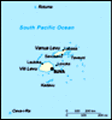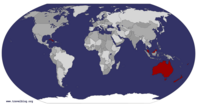Advertisement
Published: March 1st 2010
Continued…
Sadly, we’re now on our last day here in Fiji, and if all goes to plan, we’ll be landing in La la land in just a few hours*, to spend a week in San Fran, before fleeing for Cuba via a detour through Mexico. However, the crumbling and unpredictable stability of this planet means that over breakfast we watched reports on Aljazeera TV of an 8.8 earthquake in Chile. Obviously the consequences of this are devastating for the people in Chile, but it means that most countries in the Pacific are also on Tsunami alert - including Fiji. All you can do is wait for updates and keep your eye on the news. So in the mean time, I’ll tell you about our last few days of island life.
Spending another couple of very quiet and chilled days hammocking it up under the looming palm fronds of giant coconut trees at Otto and Fanny’s, another intimate family run resort built in an old coconut plantation on Tavewa Island. We relaxed further into Fiji time in the peaceful surroundings. The
longer I spend in this place, the better it gets. I can’t quite get over just how kind and generous these guys are. They instil an immense feeling of calm within you, and have voices which melt you like butter. Fiji is absolutely the place to come and clear your mind, and has definitely gotten under my skin. The food here was incredible too, and we woke up to warm coconut scones and tea for breakfast in the morning.
Moving on for Naviti, about an hour further down the Yasawas. We stayed at Botaira Lodge, a little more swanky than the rest, with huge Bures and ceilings adorned with the indigenous tribal Tapa design which you find everywhere. In stencils, screen printed onto fabrics and hangings, tattoo designs, and reflected throughout most graphics in some form or another. When Botaira Lodge acquired the plot of land on which it now stands back in 2002, they also gained a preservation order for the reef which the cove around it protects. Meaning that boats divers and snorkellers have to adhere to a similar code of conduct as you would in
a protected national park. Because of this, it means that the coral reef reserve is in an absolutely outstanding condition.
Making our way over a footpath leading you out onto the main arena, we found ourselves floating above a massive expanse of coral basin, walls of life with fish feeding in the peaks and troughs beneath the waters surface, looking out from where we hovered out into the perfect aqua blue abyss, made me want to venture further exploring all that the coral formations had to offer.
I always approach snorkelling with a little trepidation at first, knowing what lies beneath in the deep enigmatic ocean fills me with a little dread. So obviously, I have to do it anyway - just to prove to myself that I can.
We met a couple of dive instructors at Botaira, which made me want to learn to dive a whole lot more. Although, maybe I was inspired a little by the fantastic way they lived their lifes. For them, home is wherever the work is, be that touring a boat full of scientists around the British Virgin Isles or diving in the Red Sea. Maybe Fiji might be the place to return to one day to get my dive certificate and check out a Bull shark of two at Pacific Harbour??
Snorkelling with mom, is another one of those experiences where you probably had to be there. Needless to say, there was a bit more shrilling and underwater shouting, as we discovered more than we’d ever seen before when either of us had been snorkelling. So so so incredible! Apart from the inevitable shock and awe factor when you stick your head underwater and take a look at the sea life of a reef, there was an immense and vast array of fishies which I couldn’t help but flow around and terrorize.
NEMO’S!! Real bloody Nemo’s!! And Rainbow fish, Parrot fish, Lion fish, Angel fish, bright yellow fish with spot and stripes on! A SQUID! Mother Nature definitely got it right when she designed the underwater world of reef and sea life!
We watched the squid floundering around for a while and then ventured on through a few more canyons and crevices, all full of equally impressive marine life. Brilliant! Bloody fantastic!
With a couple of days left, we were determined to make the most of every single aspect of Fiji, and hopped on a bus back on Viti Levu over to Suva. The population in Fiji comprises of indigenous Fijian and Indo-Fijian’s. Who are the remaining inhabitants from the days when we - the British - introduced indentured laborers to work on the sugar crops until they earned a ticket back to India. You immediatly notice a culture shift when you spend time on the mainland, in comparison to the islands. Indo-Fijians have a real influence on the traditions in and around the main cities of Nadi and Suva.
Knowing a little about the Countries’ history from a few conversations with the locals and of course my mom! A visit to Suva’s museum added some flesh to the bones. I don’t mind museums as much as I did as a kid Now I’m allowed to take in what I want, as I want And found that I too have become one of those people who enjoys digesting every artefact a museum has to offer. The history of Fiji makes for a great story. Well documented is Cannibalism, more a method of humiliation and warning to other tribes than anything else In actual fact, was still being carried out towards the end of the 19th century. One particular tale towards the end of it’s practice, involves a missionary Reverend William Baker, and a few of his cronies being dished up by a local tribe. It’s believed that Baker pissed off the Chief of the village he practiced in, enough to warrant such a grisly demise. Charmingly you can see the bowl and fork here, which was claimed to be used in this incident, alongside a silver bowl donated by a Birmingham Ladies Society of the same mission church.. Lovely stuff! Another large marker in Fijian history is that of the Bounty ship, and it’s mutiny. On 29th April 1789 Captain William Bligh and 18 of his crew were thrown onto a rowing boat with 10 days of supplies and no compass. Bligh, is revered as a hero, as he successfully chartered the islands, and saw all but one of his mutinied passengers safely back to dry land Although the Bounty was burned and drowned off the coast of Pitcairn island, where descendants now live, you can find the remains of the ships’ udder in the museum too, which is a bit good, and certainly puts facts into context.
Heading back to Nadi, after probably the best tasting Dosa I’ve eaten outside India We prepared to leave wonderful island life, and jumped on the bus for a 4 hour journey back to Mama‘s for our last night. Everywhere you go, you are greeted as though you are a family member who has been away for a while. On returning to Mama’s in Nadi, both of us received massive bear hugs from Mama, and were put back in ‘our old room’, before settling down for our final Fiji sunset..
Everyone seems to have stories of the warnings last from December - pre-tsunami training - From the guys at Oarmans collecting the fish left behind as the tide drew out to sea to the neighbours of Otto and Fanny’s asking to borrow a wheelbarrow, so that they can get grandma up the hill! Amazing! The general attitude is, “what will be will be.” Do they have a better attitude when dealing with crisis, rather than one affected by a world filled with media glorifying, or a naïve one? Either way, the feeling of ‘Fiji time’ rubs off on you leaving you in a horizontal state of calm that I wish I could bottle up and keep for when life becomes a little too heavy.
Leaving balmy sun drenched days of kayaking, snorkelling and the odd day time napping.. behind. We must catch our plane LA bound and then onto San Francisco. Where our journey takes us Stateside!
Advertisement
Tot: 0.093s; Tpl: 0.009s; cc: 10; qc: 49; dbt: 0.0358s; 1; m:domysql w:travelblog (10.17.0.13); sld: 1;
; mem: 1.1mb








